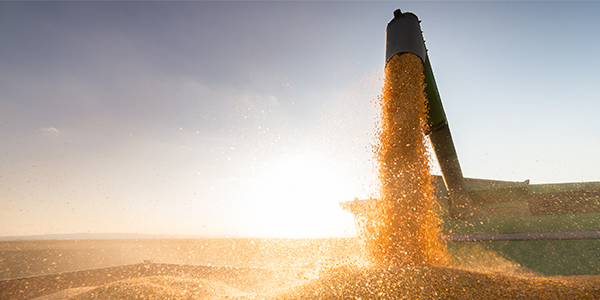AGRONOMICSUPPORT
YOU CAN TAKETO THE FIELD
Fall Scouting Paves the Way for Even Stronger Performance Next Season
Prep work for harvest should include scouting fields for late threats to yield. “Knowing the state of your fields helps limit harvest loss and plan for next season,” says LG Seeds Agronomist Al Bass.
“Don’t rely on what you hear,” says Bass, noting widespread variability this season. “Get into your fields and look.”
Bass wants farmers to keep the following five guidelines in mind this fall to improve future performance.
#1. Check stalk quality
Stalk quality is one of Bass’s primary concerns in his Wisconsin territory this season. “Stalk degradation through the fall can cost farmers a lot of yield if they’re caught unaware,” he says. The pinch test or push test helps determine if lodging is a risk.
 The pinch test involves squeezing the stalk between the second and third internode. “If it’s spongy or collapses easily, plan on harvesting the field earlier,” Bass says.
The pinch test involves squeezing the stalk between the second and third internode. “If it’s spongy or collapses easily, plan on harvesting the field earlier,” Bass says.
The push test entails pushing the stalk over to a 45-degree angle. “If more than 10% of those stalks break easily, that indicates standability issues and the need for an earlier harvest,” Bass says.
Hybrids that stood out for impressive late-season standability in Wisconsin include LG49C28 and LG52C42, according to Bass. “This season especially, we’re seeing why stalk health should factor into hybrid selection.”
 #2. Balance harvest loss with drying costs
#2. Balance harvest loss with drying costs
Another major source of loss, according to Bass, is waiting until corn dries to 15% moisture to harvest fields. “While that saves on drying cost, the likely head shelling and harvest loss outweighs any savings.”
He recommends farmers harvest when moisture is between 18% and 22%. “That strikes a good balance of minimal harvest loss and artificial drying costs,” Bass says.
#3. Look for rot, too
Farmers checking fields should also keep an eye out for stalk or ear rot. “Despite dryness, there are a few of them out there this season – likely because the stress of dryness left the corn plant more susceptible to disease,” Bass explains. “Ear rot threats include Diplodia, Gibberella and Fusarium.”
Stalk rot can compromise stalk quality, and some threats like Fusarium stalk rot can be difficult to spot because it doesn’t cause the black spots on the stalk associated with anthracnose, Gibberella and Diplodia.
“If you have stalk or ear rot, you’ll want to get that crop harvested and dried down quickly to reduce the amount of mycotoxin that’ll continue to grow,” Bass says. This is another threat that can be mitigated via hybrid selection.
#4. Assess pests and weed pressure
Bass also advises farmers to be on watch for pests that move in late in the season, like European corn borer, corn earworm or Western bean cutworm. They can threaten stalk health and shave bushels off yield.
Thankfully, there are several trait options that offer protection. “The Agrisure Viptera® trait is the best on corn earworm and Western bean cutworm,” Bass says, adding that the VT Double PRO® trait also protects against corn earworm. “Knowing what’s in your field and your general area can help with those trait decisions.”
Weed pressure is also heavier this year because dryness limited the canopy for both corn and soybeans. Bass encourages farmers to keep track of the weeds they have this fall and use that to develop a herbicide program for next year.
#5. Look at the whole picture when it comes to hybrid selection
 “Plant health matters not only during the summer when leaf diseases cause problems, but also with late-season intactness,” Bass says. “Look at the whole picture. Season-long monitoring of crops leads to better hybrid choices and prevents surprises in the fall.”
“Plant health matters not only during the summer when leaf diseases cause problems, but also with late-season intactness,” Bass says. “Look at the whole picture. Season-long monitoring of crops leads to better hybrid choices and prevents surprises in the fall.”
For help determining what products make the most sense for your farm, reach out to your local LG Seeds agronomist.






Agronomy Team